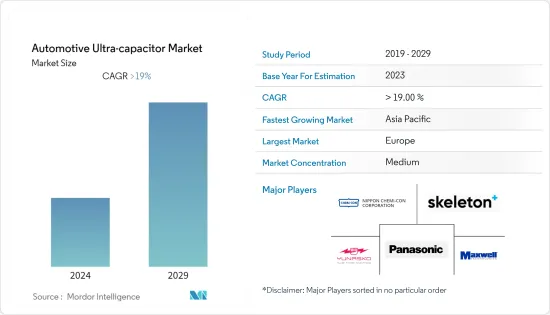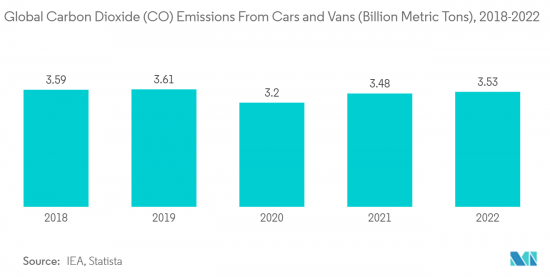
자동차용 울트라커패시터(Automotive Ultra-capacitor) 시장은 현재 15억 달러로 평가되고 있습니다.
향후 5년간 42억 7,000만 달러로 성장해 예측 기간 중 CAGR 19%를 나타낼 것으로 예측되고 있습니다.

중기적으로는 엄격한 배출가스 규제와 연비규제가 제정되어 전기 자동차 보급률을 높이기 위한 보조금이나 급부금 등 정부의 대처가 증가하고 있기 때문에 예측기간 중에 큰 성장이 예상된다 됩니다.
울트라커패시터의 사용은 배터리 부하를 확대하여 자동차 제조업체가 연비 효율, 배터리 수명 연장, 차량 중량 감소, CO2 배출량 감소를 달성할 수 있게 했습니다. 울트라커패시터는 세계적으로 엄격한 배기가스 규제에 대응하기 때문에 기존, 하이브리드, 전기 자동차 등 모든 유형의 자동차에 급속히 보급될 가능성이 높습니다.
일반적으로 차량 배터리와 함께 연결되는 울트라커패시터는 시동/정지 및 회생 제동 시 발생하는 짧은 간격(30초 미만)의 피크 부하 수요를 지원합니다. 울트라커패시터가 제공하는 높은 에너지의 빠른 충전 및 방전 용량 덕분에 자동차 제조업체들은 시동/정지 시스템과 회생 제동 시스템에 울트라커패시터를 채택하고 있습니다. 차량의 내연기관, 연료 전지, 배터리와 같은 1차 에너지원은 피크 전력 수요를 처리하거나 위의 용도에서 에너지를 회수하는 데 비효율적인 것으로 확인되었습니다.
세계의 각국 정부는 배출량 저감을 위한 야심적인 목표를 설정하고 있으며, 전기 자동차 이용 촉진은 이러한 목표를 달성하기 위한 한 가지 방법으로 여겨지고 있습니다. 예를 들어 유럽연합(EU)은 2030년까지 온실가스 배출량을 55% 삭감하는 것을 목표로 하고 있으며, 중국은 2025년까지 신차 판매 대수의 25%를 전기 자동차로 삼겠다는 목표를 내걸고 있습니다.
대부분의 전기 자동차에 사용되는 리튬 이온 배터리는 에너지 밀도, 충전 시간 및 전반적인 성능 측면에서 크게 향상되었습니다. 이로 인해 전기 자동차는 더 실용적이게 되었으며, 소비자에게 매력적으로 작용합니다.
EV에 대한 수요 증가는 배터리 화학 및 재료의 기술적 진보로 이어집니다. 안전과 성능을 보장하기 위해서는 보다 정교하고 효율적인 자동차 배터리가 필요합니다. 많은 유명한 자동차 제조업체들은 자동차 배터리 제조업체와 장기적인 거래 관계 구축에 주력하고 있습니다. 예를 들면
미국 환경보호청(EPA)과 미국 운수성 도로교통안전국(NHTSA)은 연비 향상과 이산화탄소 배출량 감소를 보장하기 위해 친환경 자동차(승용차와 상용차 모두) 생산을 지원하기 위해 노력하고 있습니다. 이러한 노력을 통해 정부는 2025년까지 약 31억톤의 CO2 배출량을 줄이고 약 60억 배럴의 석유를 절약할 계획입니다.
또한 유럽연합(EU)은 승용차와 상용차의 CO2 배출 수준을 규제하는 배출 기준을 설정했습니다. 운송의 배출량은 최근 증가하고 있으며, 현재는 EU 전체의 온실가스 배출량의 1/4을 차지하고 있습니다.
그 결과 유럽위원회, 유럽 의회, EU 회원국은 2025년부터 2030년까지 소형차 CO2 규정을 연장할 준비를 하고 있습니다. 또한, 위의 기준을 충족하기 위해 울트라커패시터의 채택이 증가하고 있어 예측기간 동안에도 유사한 동향이 예상됩니다.
위와 같은 세계 시장 개척으로 인해 시장은 예측 기간 동안 큰 성장을 이룰 가능성이 높습니다.

유럽에서는 하이브리드 자동차 및 전기 자동차 판매가 급속히 성장하고 있으며 자동차에서 전기 에너지의 최적 사용을 충족시키기 위해 울트라커패시터 수요가 증가할 것으로 예상됩니다.
각 지역의 자동차 제조업체와 생태계 이해관계자들은 고객의 필요성와 선호도에 따라 변화하는 지역 패턴에 적응하기 시작했습니다. 자동차 수요 증가와 세계 생활 수준의 향상으로 연구 대상 시장이 확대될 것으로 예상됩니다. 또한 도시화의 진전과 인구 증가가 자동차 수요를 낳았습니다.
아시아 태평양 시장은 인프라 개척과 자동차 판매 증가로 예측 기간 동안 더 빠른 속도로 성장할 것으로 예상됩니다. 또한 자동차에 전자부품이 대량으로 사용되고 있는 중국이 수익면에서 시장을 선도하고 있으며, 일본, 한국, 인도가 이에 이어지고 있습니다.
중국은 세계 최대의 전기 자동차 제조·소비국입니다. 판매 목표, 유리한 법률 및 지자체의 대기질 목표가 국내 수요를 지원합니다. 예를 들어,
중국은 이미 하이브리드 버스에 슈퍼커패시터를 사용하고 있습니다. 이러한 버스에는 스톱 스타트 엔진이 탑재되어 있어 슈퍼커패시터에 의해 배터리에 대한 부하가 경감되기 때문에 배터리의 수명이 연장됩니다.
지속적인 혁신으로 중국 제조업체는 슈퍼커패시터 포트폴리오를 확대하고 있습니다. 중국의 국유 철도 차량 제조업체로 세계 최대의 철도 건설 회사인 CRRC는 보다 고효율로 장기간 전기 버스에 전력을 공급할 수 있는 그래핀 기반 슈퍼커패시터를 개발했습니다.
자동차용 울트라커패시터 시장은 Maxwell Technologies, Skeleton Technologies, Kemet Corporation, Panasonic Corporation 등 여러 주요 기업에 의해 지배되고 있습니다. 제조 시설의 급속한 확대, 자동차 제조업체와 부품 제조업체 간 파트너십 증가는 예측 기간 동안 시장의 큰 성장을 보여줄 가능성이 높습니다. 예를 들면

The automotive ultra-capacitor market is valued at USD 1.50 billion in the current year. It is anticipated to grow to USD 4.27 billion by the next five years, registering a CAGR of 19% in terms of revenue during the forecast period.
Over the medium term, the enactment of stringent emissions and fuel economy norms and increasing government initiatives, in terms of subsidies and benefits for increasing the adoption rate of electric vehicles, is expected to witness major growth during the forecast period.
The use of ultra-capacitors expanded the battery load and enabled vehicle manufacturers to achieve fuel efficiency, extended battery life, reduced vehicle weight, and reduced CO2 emissions. Ultra-capacitors are likely to penetrate at a faster rate in all vehicle types, including conventional, hybrid, and electric vehicles, to meet the growing stringent emission rules across the world.
Ultra-capacitors, typically connected in tandem with vehicle batteries, support peak load demands for short intervals (which are less than 30 seconds) encountered during start/stop and regeneration braking applications. The capacity for quick recharge and discharge of high energy offered by ultra-capacitors drove the vehicle manufacturers to deploy them in the start/stop systems and regenerative braking systems. Primary energy sources, like internal combustion engines, fuel cells, and batteries in vehicles, were identified to be inefficient in handling peak power demand or recapturing energy during the applications above.
Governments around the world are setting ambitious targets to reduce emissions, and promoting the use of electric vehicles is seen as one way to achieve these goals. For instance, the European Union aims to reduce its greenhouse gas emissions by 55% by 2030, and China set a target of having 25% of new cars sold by 2025 to be electric.
Lithium-ion batteries, which are used in most electric vehicles, saw a significant improvement in terms of energy density, charging time, and overall performance. It made electric vehicles more practical and appealing to consumers.
The growing demand for EVs will lead to technological advancements in battery chemistry and materials. It will require more sophisticated and efficient automotive batteries to ensure safety and performance. Many prominent automobile manufacturers are focusing on building long-term business relationships with automotive battery manufacturing companies. For instance,
The United States Environmental Protection Agency (EPA) and the National Highway Traffic Safety Administration (NHTSA) are taking initiatives to support the production of eco-friendly vehicles (both passenger vehicles and commercial vehicles) to ensure improved fuel economy and reduced carbon emissions. Through these initiatives, the government is planning to reduce about 3,100 million metric tons of CO2 emissions and save about 6 billion barrels of oil by 2025.
Additionally, the European Union (EU) set emission standards to regulate the CO2 emission levels of passenger cars and commercial vehicles. Transport emissions increased in recent years and now account for a quarter of the EU's total GHG emissions.
As a result, the European Commission, European Parliament, and EU member states are preparing to extend the light-duty vehicles' CO2 regulation to 2025-2030. Furthermore, to meet the standards above, the adoption of the ultra-capacitor is increasing and is expected to witness the same trend during the forecast period.
With the development mentioned above across the globe, the market is likely to witness major growth during the forecast period.

With the rapidly growing hybrid and electric vehicle sales in the European region, the demand for ultra-capacitors is anticipated to grow to meet the optimal utilization of electric energy in vehicles.
Automotive manufacturers and ecosystem stakeholders in each region began to adapt to the changing regional patterns based on customer needs and preferences. The market studied is expected to expand due to rising vehicle demand and rising living standards around the globe. Furthermore, increased urbanization and an increasing population created a demand for automobiles.
The Asia-Pacific market is expected to grow at a faster pace during the forecast period, owing to development in infrastructure and increased vehicle sales. Furthermore, China is leading the market in terms of revenue due to its massive use of electronic components in vehicles, followed by Japan, Korea, and India.
China is the largest manufacturer and consumer of electric vehicles in the world. Sales targets, favorable laws, and municipal air-quality targets are supporting domestic demand. For instance,
China is already using supercapacitors in hybrid buses. These buses are equipped with stop-start engines, in which supercapacitors reduce the load on the battery, which increases the lifetime of the batteries.
Due to continuous innovation, Chinese manufacturers are expanding their supercapacitor portfolio. The CRRC, the Chinese state-owned rolling stock manufacturer and the world's largest train builder developed graphene-based supercapacitors that may power electric buses with higher efficiency and for a longer period.
The automotive ultra-capacitor market is dominated by several key players, such as Maxwell Technologies, Skeleton Technologies, Kemet Corporation, and Panasonic Corporation, among others. The rapid expansion of manufacturing facilities and an increase in partnership between the vehicle manufacturer and the component manufacturer is likely to witness major growth for the market during the forecast period. For instance,